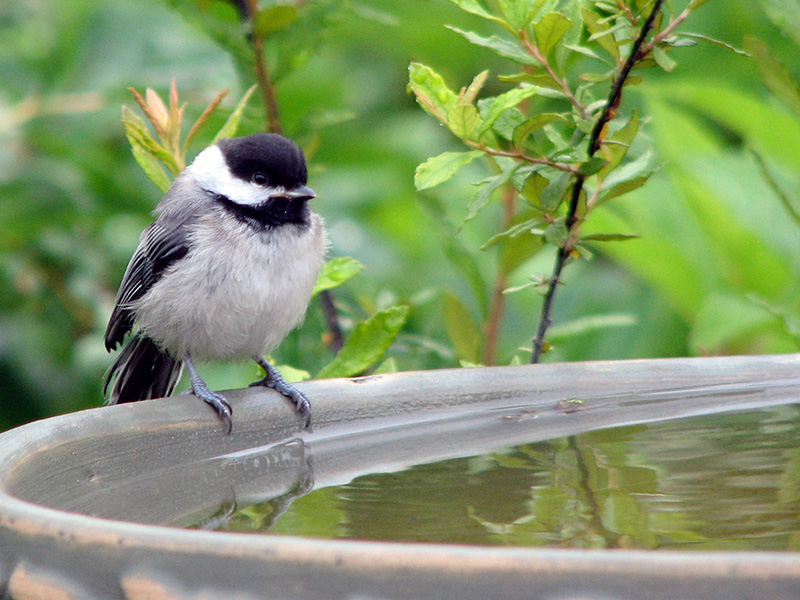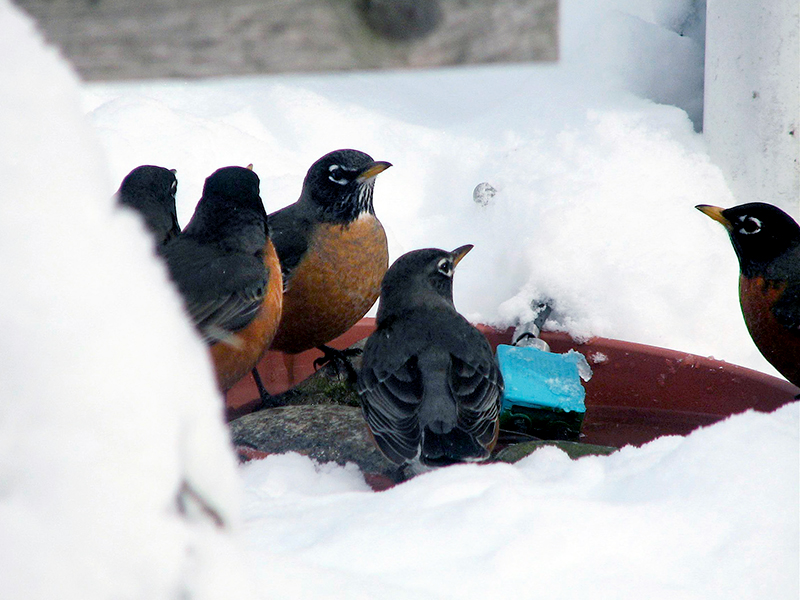Until we built our pond, we maintained a traditional “birdbath on a pedestal” as well as a large flowerpot saucer we placed on the ground. Different birds seemed to prefer one or the other of these, so we had both. And small creatures like chipmunks also use a ground-level source of water.


Since we’ve built our pond, though, we haven’t provided a birdbath except in winter, and then we use a plastic saucer with a small coil heater.
We also cover the bottom with stones so birds cannot bathe, just get a drink. Frozen feathers don’t work!
(And definitely NO antifreeze! It’s poison!)
Keeping birdbaths clean
One reason I like having our ponds is that a birdbath needs to be kept clean.
When I did use birdbaths, I scrubbed them with an old vegetable brush every three days or so, depending on how much they had been used. This is important for the birds’ health, but also (in the summer) to prevent mosquitoes from breeding. REMEMBER: It takes a week (possibly longer) for mosquitoes to develop from egg to adult, so changing the water solves the problem.
In the past, it was easier and faster to fill a few gallon milk jugs in the kitchen (with caps on to prevent mosquitoes) and keep them and a scrub brush close to the birdbath. We always try to make it easy to do the right thing!
Placing the birdbaths
We located our birdbaths where birds would feel comfortable and be safe using them. They’re safer when they’re not in the midst of bushes or tall flowers since predators such as cats could hide in the vegetation. Being farther gives them a chance to get away should they spot a predator.
Generally, 10 to 12 feet from cover is the recommended distance since it’s not too far to fly in a bird emergency. Birds don’t easily come “up to speed” when their feathers are wet!
Dripping water
Dripping water attracts birds. I tried both commercial and homemade systems before we had a pond and stream.
The commercial one required that the hose always be on and connected. The homemade one was simply a milk jug with a very tiny hole in the bottom suspended over the birdbath. Even with a small hole, though, it needed refilling too frequently.
Neither was satisfactory, so we didn’t use either one very long. We’re glad we now have the ponds and stream.
Resources
- Plastic and ceramic birdbaths may have slippery slopes. If yours does, add sand or rough stones to the bottom to provide birds with better footing. In summer, the best location for a birdbath is in the shade, to minimize evaporation and algal growth. The activity at birdbaths often attracts neighborhood cats and other predators, and birds with wet feathers are often clumsy fliers, so it’s best to situate birdbaths near trees or shrubs where the birds can retreat if a predator is spotted.
~ Laura Erickson, 101 Ways to Help Birds, p. 153 - Cornell Lab of Ornithology’s All About Birds:
- Cool Green Science (Nature Conservancy)
- Bird Watcher’s General Store:
- Mosquitoes no problem in a birdbath – Humorous, but accurate
